
Navigating Electronic Literature
by: Jessica Pressman
Navigation is an element of electronic literature that uniquely affects the ways in which we read and interact with digital textuality. Unlike print literature, electronic literature does not consist of stable, inscribed marks on a print page; rather, it emerges as a processural performance across codes and circuitry within the computer and in response to interactions from the reader. Such navigational interactions range from clicking on a hyperlink in a hypertext to typing a response to a narrative prompt in interactive fiction or moving an avatar through virtual spaces in immersive narrative. As we will see, each of these genres utilizes a different type of navigational action, but cumulatively they demonstrate how navigation is not only a central characteristic of the digital literary work and its aesthetic but also a primary source of its signification. Focusing on the role of navigation in electronic literature can lead to valuable discussions not only about individual works but also about electronic literature in general and its relationship to traditional literary studies. Navigation can therefore serve as an entrypoint for meta-critical inquiry into the ways in which we read, think, and interpret information through media-specific ways.
Navigation is not just how readers move through electronic literature but how they read digital works. When and how the reader inputs a command, whether it is a mouse-click or a typewritten word, this action affects the work’s performance and the reader’s engagement with it. In other words, navigation enables the digital work’s performance and its signification. To understand how navigation is signification in electronic literature, let’s examine a few modes of navigating electronic literature and the their distinct effects on the reading practices and signification processes they produce.
The first example of navigational structure I mentioned at the beginning of this essay is also one of the earliest and predominant forms of electronic literature: hypertext. In a hypertext the reader navigates a non-linear, branching narrative by clicking on hyperlinks to access new lexias, or chunks of text. For example, clicking on the underlined, hyperlink words “the bodies,” “police,” or “window” in the following screen from Deena Larsen’s Disappearing Rain (2000) triggers the appearance of new windows (or lexias) containing different narrative text and yielding new reading paths.(Note 1)
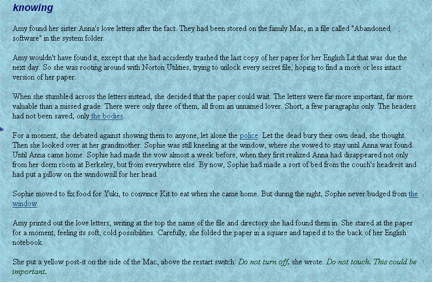
Hypertext has its foundation in print texts (from Lawrence Sterne's Tristram Shandy [1759] to Vladmir Nabokov’s Pale Fire [1962]), but the digital form of this genre produces unique questions and theoretical implications for readers and students of literature. How one navigates a hypertext determines what one reads and in which order. This fact has lead some critics, like George P. Landow, to identify hypertext as offering readers more agency, and even partial authorship, over the text they read than print texts.(Note 2) Other critics, like Espen Aarseth, criticize this view, pointing out that the authors of hypertexts program all possible paths through which readers can navigate and thus invite only “trivial” rather than productive (or “ergodic”) action from the reader.(Note 3) Regardless of your view, however, navigating a hypertext not only promotes questions about the role of the reader and the reading practice but also about the structure and signification of literature itself.
Navigating electronic literature is an act of producing a work’s signifying properties in the moment of engagement with them, and Jim Andrews’s “stir fry texts” provide a particularly clear example of this fact. These text-based works adapt the networked links and associative mapping elements of hypertext into an aesthetic that illuminates how navigation serves as signification in electronic literature. Andrews conceives of his “stir frys” as related to William Burrough’s “cut-up method” of producing literature, but in these digital works the reader is the one who enacts the “cut up” through her navigational acts. The shades of blue in “Blue Hyacinth” represent sections of a cohesive text which have been “cut-up” and programmed to form amalgamations onscreen in response to the reader’s actions. The following screenshots are from “Blue Hyacinth” (created with Pauline Masurel, [2002]), and they do not do justice to the effect of interacting with the work; but they do illustrate how navigation not only enables the text to appear but also becomes its primary aesthetic and mode of signification.(Note 4) The reader encounters the following text onscreen:
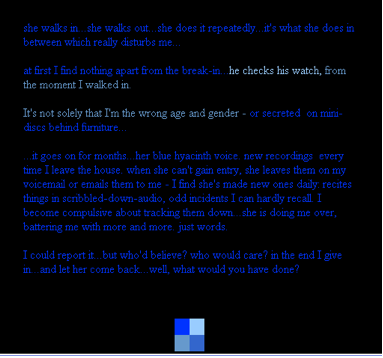
Mousing over any of the text initiates a change of content. However, unlike a hypertext, wherein a mouse click opens a new lexia or browser window, the textual mutations in “Blue Hyacinth” occur on the same screen. In a fast and fluid manner, the content shifts before the reader’s eyes and under the reader’s mouse. The following screenshot depicts one effect of mousing-over the previous screen from “Blue Hyacinth”:
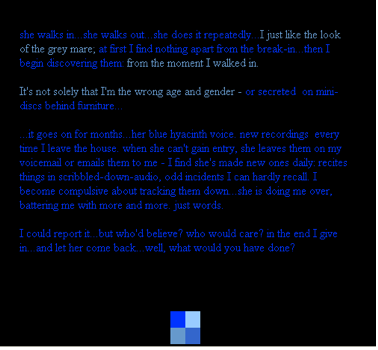
Watching the colors flicker and the content mutate, the reader grows aware of the power of her mouse as a navigational tool to impel change in the work. “Blue Hyacinth” presents navigation as the central factor determining the content and signification of the work. This effort is particularly apparent in certain sections of the work wherein the text is programmed to respond to the stillness of the reader’s mouse. When the reader holds her mouse over a word or sentence, the text beneath flickers spasmodically as its content mutates rapidly. The presence of the mouse prompts such a fast-flashing of text that the reader cannot comprehend all of the transformations. Andrews describes this effect as a “spastic interactivity” which he sees as “allow[ing] you to make your own texts.” (Note 5) If navigating the stir frys means “mak[ing] your own texts,” then navigation is not only how readers engage with digital works but also how they produce and experience them. In this sense, navigation becomes the key to reading electronic literature, and reading becomes a practice that must be relearned and reconsidered with each digital work.
Navigating a nonlinear narrative such as a hypertext, or a related form like Andrews’s stir frys, demonstrates how electronic literature challenges expectations associated with and codified around print-based reading practices. Since hypertexts are structured as networks rather than linear plots, they lend themselves to openness and disorientation. Some hypertexts may not even contain a definitive ending but instead continue in endless loops of lexias; such works depend upon the reader to resolve when to finish reading the work. In other words, the navigational aspect of hypertext changes our interaction with both the story at hand and also with the concept of narrative itself. As Jay David Bolter writes, in hypertext “[t]here is no single story of which every reading is a version, because each reading determines the story as it goes. We could say that there is no story at all; there are only readings” (124).(Note 6) Aside from questions of narrative structure and aesthetics, the navigational aspect of hypertext also has important pedagogical implications for teachers and students of electronic literature. How do you assign a hypertext to a class knowing that students will inevitably read different lexias in different orders and perhaps even access dissimilar narrative content altogether? Additionally, if a hypertext lacks page numbers or a set ending, do you assign an amount of reading time (e.g. read for 3 hours) instead of a specific quantity of content (e.g. read pages 1-100)? How do you conduct classroom discussions about a work whose navigational structure produces individual reading paths and engagements with its content? These are all not only pedagogical challenges but also valuable teaching points and topics for in-class discussion.
Other genres of electronic literature employ navigational actions that result in distinct relationships between the reader and the narrative that stimulate pressing questions about the nature of the digital literary work. Interactive fiction (IF), the second example referred to at the beginning of this essay, often calls upon the reader to manually input text in response to a query or narrative turn. This is the navigational format of Andrew Plotkin’s Shade (2000), from which the following screenshot is taken:(Note 7)
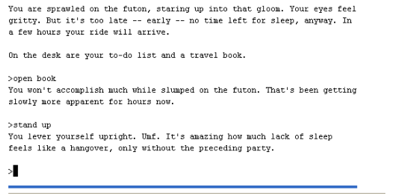
After reading a chunk of narrative, the reader types in directives (displayed beside the >), to which the work responds by unveiling more of the narrative. The reader’s act of writing thus affects the trajectory of the narrative in a similar manner to the nonlinear, linking mechanism of hypertext; but, in the case of such IF works, and in contrast to hypertext, navigation is textual and semiotic rather than spatial. What aesthetic effect or affect does the navigational act of writing have on the reader and her reading process? Such works stimulate discussion about the identification and location of the “text”: Where is the text, the narrative to be read and discussed, in an IF scenario? Should the reader analyze the text onscreen (i.e. the end-product of the interaction with the computer) or the way in which the program responds to her own input (i.e. the manner in which the work is programmed)?
The difficulty of identifying the “text” in electronic literature is made even more apparent in interactive works that engage the reader as a character navigating through the narrative. Michael Mateas and Andrew Stern’s Façade (2005) is exemplary of an emergent genre of works (which could arguably also include games) that employ a navigational model in which the reader maneuvers through the narrative by way of an avatar.(Note 8) The “interactive story,” as Mateas and Stern call it, presents the reader as a character in a narrative situation. This particular work begins by literally inviting the reader (and her avatar) into the apartment, and the domestic drama, of a newlywed couple.
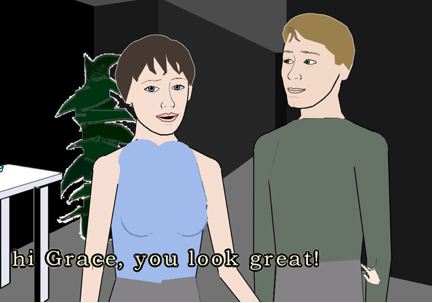
The reader navigates the virtual space using the arrow keys and interacts with the characters by typing in textual responses to their statements. In turn, the characters respond to the reader’s actions, and the narrative develops accordingly. The navigational structure of this work both diverges from and shares similarities with the purely textual form of query and response in interactive fiction and also the link-and-node structure of hypertext. Such a work demands that attention focus on the reader’s specific navigational actions and their repercussions on the resulting narrative. Works like Façade exacerbate questions about what one defines as the “text” and how one “reads” it. Is the narrative contained in the emergent interaction with the work or in the resulting display of text produced after the performance has ended? Or, as some critics would argue, is the work located in the programming code that remains unseen by the reader during her interaction with the characters but which produces the narrative action onscreen? Such questions are currently being debated in electronic literary criticism, and the discourse they stimulate illuminates the unique, processural nature of digital textuality.(Note 9) These questions testify to the fact that emergent forms of electronic literature complicate the ways in which we think about and engage with literature.
Not only is literature changing as it becomes digital, but so too are our reading practices. Reading electronic literature is not only about accessing or receiving texts but also about producing and performing them. Focusing on how navigation alters the reading practice exposes the print-based nature of our expectations about the literary. In my experience teaching electronic literature, student frustration with navigation and confusion about the reading experience can be turned into fruitful, self-reflective discussions about the role of media on the ways in which information is produced, disseminated, archived, and taught. I often use discussions of specific works of electronic literature as springboards for examination into how the technology of the book informs our expectations about and interactions with narrative across media forms. Works like the ones discussed in this brief essay identify navigation as not only a significant element of an individual work and the reader’s experience of it but also a vital feature of larger discussions about what literature is and what it does in a digital environment.
- http://www.deenalarsen.net/rain/
- See Hypertext 2.0: The Convergence of Contemporary Critical Theory and Technology, 2nd ed., (Baltimore: Johns Hopkins University Press, 1997).
- See Cybertext: Perspectives on Ergodic Literature (Baltimore: Johns Hopkins University Press, 1997).
- http://vispo.com/StirFryTexts/bluehyacinth3.html
- http://vispo.com/StirFryTexts/text.html
- Jay David Bolter, Writing Space: The Computer, Hypertext, and the History of Writing (Hillsdale, New Jersey: Lawrence Erlbaum, 1991).
- http://eliterature.org/2005/07/plotkins-shade/
- http://interactivestory.net/
- For more on this debate, see the postings by John Cayley, Rita Raley, and Mark Marino on this subject at the electronic book review. Cayley’s “The Code is not the Text (Unless it is the Text)” (September 2002) appears at http://www.electronicbookreview.com/thread/electropoetics/literal [Accessed March 2007], Raley’s “Interferences: [Net. Writing] and the Practice of Codework.” (September 2002) at http://www.electronicbookreview.com/thread/electropoetics/net.writing. [Accessed March 2007], and Marino’s “Critical Code Studies” (December 2006) at http://www.electronicbookreview.com/thread/electropoetics/codology [Accessed March 2007].